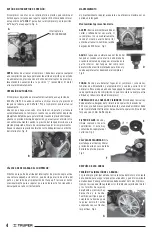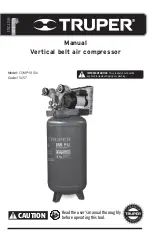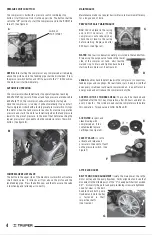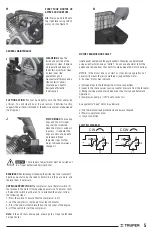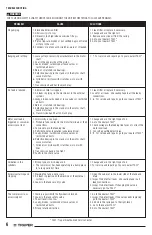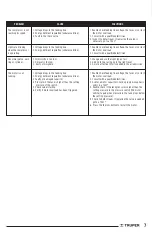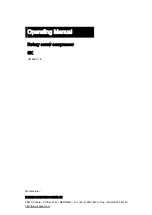
6
TROUBLESHOOTING
FOR YOUR OWN SAFETY ALWAYS TURN OFF AND DISCONNECT THE UNIT BEFORE TRYING TO SOLVE ANY PROBLEM.
CAUSE
1. Blocked admission filter
2. Oil viscosity is to low.
3. Oil level is too high (when excessive fill-up is
possible).
4. Piston rings are broken or not settled. Gaps not tiered
or stuck in the slot.
5. Cylinders or pistons with scratches, worn or streaked.
1. Loose pulley or excessive axial backlash in the motor
shaft.
2. Coal in the upper side of the piston.
3. Leaky, broken, carbonized or loose valves or
restricted air ducts.
4.Worn or scratched rod bearings
5. Defective bearing in the crank or in the motor shaft.
Loose motor fan.
6. Cylinders or pistons with scratches, worn or with
lines.
7. Transmission band has too much play.
1. Admission filter is clogged.
2. Air leaks in piping (in the machine or in the external
system).
3.Leaky, broken, carbonized or loose valves or restricted
air ducts.
4.Worn or scratched rod bearings
5. Defective bearing in the crank or in the motor shaft.
Loose motor fan.
6. Transmission band has too much play.
1. Oil viscosity is too high.
2. Probable false contact in the motor terminals or their
connections.
3. Tension drop in the feeding line.
4. Deficient energy regulation (unbalanced line).
5. Leaky, broken, carbonized or loose valves or
restricted air ducts.
6. Defective bearing in the crank or in the motor shaft.
Loose motor fan.
7. Cylinders or pistons with scratches, worn or with
lines.
8. Transmission band is too tight
9. Faults in the check valve.
1. Wrong type of oil is being used.
2. The compressor has been operating in a damp place
for a long period of time.
1. Draining the tank is necessary.
2. Air leaks in pipeline (in the machine or the external
system).
3. Leaks in the tank security valve
1. There is a possibility the flywheel is blocked.
2. Leaks in the tank safety valve.
3. The oil level is too low.
4. Leaky, broken, carbonized or loose valves or
restricted air ducts.
5. Wrong rotation direction.
SOLUTIONS
1. Clean filter or replace if necessary.
2. Change and use the right oil.
3. Remove excessive oil from the casing.
4. Go to your nearest TASC*
5. Go to your nearest TASC*
1 - 7. For service and repairs go to your nearest TASC*
1. Clean filter or replace if necessary.
2. Look for air leaks. Use sealing tape in all the leaky
connections.
3 - 6. For service and repairs go to your nearest TASC*
1. Change and use the right type of oil.
2. Go to the nearest TASC*
3. Check voltage in the feeding line fuses or correct the
motor overload.
4. Consult a qualified electrician.
5 - 9. For service and repairs go to your nearest TASC*
1. Change and use the right type of oil
2. For service and repairs go to your nearest TASC*
1. Open the valve set in the lower side of the tank and
drain.
2. Inspect to detect air leaks. Use sealing tape in all
leaky connections.
3. Inspect to detect leaks. If changing the valve is
necessary go to a TASC*
1. Go to the nearest TASC*
2. Inspect to detect leaks. If the valve needs replacing
go to the nearest TASC*
3. Add oil in the casing up to the right level.
4. Go to the nearest TASC*
5. Go to the nearest TASC*
PROBLEM
Oil pumping
Banging and rattling.
Air feed is reduced.
Motor overload is
triggered or consumes
excessive current
Oxidation in the
cylinders
Excessive starting and
stopping
The compressor runs
excessively hot
* TASC: Truper® Authorized Service Center.
EVERY FOUR MONTHS OR
AFTER 500 HOURS USE
OIL:
Drain oil and refill up to
the right level using SAE-30
motor oil. (See figure H)
GENERAL MAINTENANCE
CLEANSING:
Keep the
inside and outside of the
compressor clean. Replace
oil regularly and keep all
the external surfaces clean.
A clean inner side
guarantees good
mechanical efficiency and a
clean exterior allows
circulating air heat to
dissipate efficiently.
(See figure I).
SUCTION ACTION:
Put your hand lightly onto the filter admission
orifices. You will clearly hear the air suction. A deficient suction
suggests the air filter is blocked or the admission valves are damaged.
(See figure J).
PISTON RINGS:
The sealing
rings and the oil-scraper
ring shall be inspected
when the motor is using oil
in excess. It indicates the
rings are worn and need to
be replaced. When
replacing rings or other
major components always
change oil.
These types of adjustments must be carried out
in a Truper Authorized Service center.
BEARINGS:
When reviewing or changing the piston rings, the crankshaft
bearings must also be checked to determine if they are worn, and
replace them if necessary.
OVERLOAD PROTECTION:
The compressor has a thermal switch (P)
that prevents the motor from heating up excessive. The motor shuts
off when the switch is activated. To re-establish the motor, follow
the following steps:
1.- Press the switch to ensure that the compressor is off.
2.- Let the compressor cool down for at least 5 minutes
3.- Press the thermal switch located on the top cover of the engine.
4.- Lift the switch to start the compressor.
Note:
If the unit shuts down again, please go to a Truper Authorized
Service Center
MOTOR TRANSMISSION PULLEY
Isolate power and remove the guard and belt. The pulley can be removed
using an extractor known as “Ouller”. Do not use a hammer to hit the
pulley and remove from the shaft. It could damage the motor bearings.
MOTOR: If the motor does not start or stops during operation not
necessarily means there is something wrong with the motor.
A “buzzing” motor may indicate:
a) Voltage drops in the feeding line or loose connections.
b) Leaks in the check valves causing counter-pressure from the receptor.
c) Wrong starting procedure is being used (See Start up and Automatic
Operation).
d) Compressor pump is “stiff” due to lack of oil.
An apparently “dead” motor may indicate:
a) The thermal overload protection device was activated.
b) Power supply fuses blew.
c) Loose connection.
ELECTRIC DIAGRAM
WARNING



